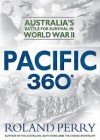Pacific 360°: Australia’s Battle for Survival in World War II1
Written by: Roland Perry,
Hachette, 2012,
ISBN 9780733632778, 512pp
Reviewed by: Wing Commander Mark Smith
When I first pick up a book I usually read the cover flap to gain some understanding of its subject matter. The cover flap of Roland Perry’s Pacific 360° told me that, ‘In the dark days following the 1941 fall of Singapore ... Churchill was demanding our troops stay in North Africa and Greece ...’ This did not bode well!
Next, with books of this ilk, I read the preface and introduction to gauge the themes, premises and arguments the author intends to convey to the reader. This sets a framework that I can use to judge the success of the book and how well the author achieves his aim. I was to face further disappointment with this book which contained neither preface nor introduction.
So what is this book about? According to the cover flap, it is ‘... an intensely revealing account of Australia’s role in the Pacific War ...’ Considering that the book contains only 465 pages of narrative, I wondered how it could cover such a complex subject with any degree of depth. Unfortunately, my verdict was ultimately that this the book had failed in its stated mission.
Pacific 360° attempts to augment the recent populist theory that a ‘Battle for Australia’ was waged in the Pacific region, a theory ably discounted by Dr Peter Stanley.2 Perry makes much of the dispute between the Japanese Army and Navy over plans to invade Australia. Some of his points in this discussion are unreferenced and it can only be assumed that these are his own conclusions. The book’s 93 chapters are divided into eight parts with parts four and six titled ‘The Battle for Australia July – September 1942’ and ‘The Battle for Australia 1943’ respectively, reinforcing this theory.
At times the writing tends towards a ‘Boys’ Own Annual’ style with Australians described as ‘ANZAC warriors’, while their opponents the Japanese ‘slinked away’; aircraft are ‘the bigger beasts of the air’, the enemy is ‘duped’ and ‘pulverised’ — just a few of the highly colourful phrases that occur throughout the book. Perry attempts to tell his story in conversational style, emulating authors such as Peter Fitzsimons; however, this approach becomes confused as this book attempts to describe too broad a range of action and, consequently, does none of these actions justice.
The Battle for Kokoda is essentially placed at the forefront, occupying the bulk of the book, some 100 pages. But even here Perry has succumbed to some of the myths of Kokoda, primarily that the Australian forces were significantly outnumbered.3 Unfortunately other equally important engagements are glossed over, their complexities and the achievements of their protagonists diminished in comparison. The enormously significant Milne Bay, Gona, Buna and Sanananda are limited to a few pages each. Sections covering Wau and the ensuring fight through to Salamaua are also short, as are details on Nadzab, Lae, Finschhafen and Sattelberg. There is no mention of the coastal trek from Finschhafen north and west through Sio to Madang. Even Shaggy Ridge is restricted to one short paragraph. While numerous place names are mentioned the book, the only map is a large-scale map of the Pacific Ocean divided into the operational areas. This is a significant omission given the level of detail the author is trying to convey to the reader.
For anyone with an interest in the RAAF and RAN operations in this theatre, the book falls woefully short on detail, often limited to mentions of support provided by ‘allied’ air forces or naval units. While the author describes various actions resulting in the award of the Victoria Cross, Flight Lieutenant Newton’s award is an obvious omission considering that the book ‘... takes you inside the horrors of Australian POW camps ...’
Pacific 360° would have benefited from some thorough proof-reading to eliminate fundamental errors such as the glaring mistake on the cover flap and a reference to John Curtin ‘... missing eight hours, wandering around ... Mt Ainslie, a few kilometres away ... across Lake Burley Griffin’. Lake Burley Griffin, of course, was not constructed until the early 1960s. Further, on page 371, the author refers to ‘... Eather’s 25th Battalion ...’ entering Lae. Eather commanded the 25th Brigade which included the 2/25th Battalion, not the 25th Battalion, a totally different unit. Finally, from an Air Force perspective, on page 408, ‘“There are drawbacks in the lines of communication between [Air Vice Marshal] Jones and [Air Vice Marshal] Bostock,” Blamey said, referring to the chiefs of the United States’ and Australia’s air forces.’ There were certainly difficulties between Jones and Bostock, but both were senior leaders in the RAAF, neither being chief of the United States’ air forces.
Overall, I found this book disappointing in that it failed to provide ‘... an intensely revealing account of Australia’s role in the Pacific War ...’ primarily because it glossed over an enormous number of actions and issues that were as important to the allied victory as Kokoda. I would hesitate to recommend this book to anyone with even a modicum of interest in the Pacific War, even as a primer.
Endnotes
- The paperback version of this book is titled The Fight for Australia: From Changi and Darwin to Kokoda - Our Battle for Survival in World War II
- See Peter Stanley, ‘What is the Battle for Australia?’ Australian Army Journal, Vol. iv, No. 2, pp.17 –33.
- See Peter Williams, The Kokoda Campaign 1942 – Myth and Reality, Australian Army History Series, Cambridge University Press, Melbourne, 2012.

